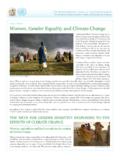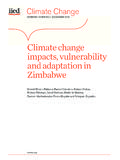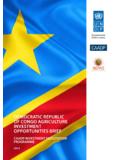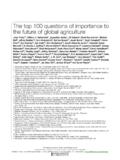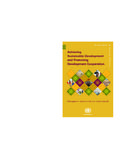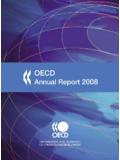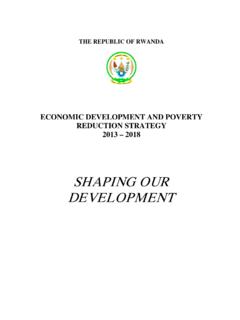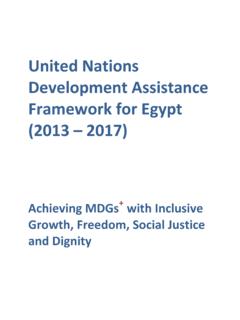Transcription of GENDER AND CLIMATE CHANGE ISSUES IN …
1 Module 2: Concepts: GENDER and CLIMATE CHANGE ISSUES in agriculture and food security 15 Module 2: Concepts: GENDER and CLIMATE CHANGE ISSUES in agriculture and food security In this module you will: review the key concepts of CLIMATE CHANGE ; explore CLIMATE -smart practices from a GENDER perspective; and understand the importance of researching and addressing GENDER ISSUES in the context of agriculture , food security and CLIMATE CHANGE . A. What is CLIMATE CHANGE ?1 You are probably already familiar with the environmental explanation of global CLIMATE CHANGE , as well as some of the policy responses; here is a brief summary. You are encouraged to consult additional resources depending on your level of familiarity with these ISSUES (see Annex 1 for glossary and Annex 2 for additional resources).
2 Figure 1: The greenhouse effect mechanism (GRIDA, 2011.) 1. The Enhanced greenhouse effect The Earth s atmosphere naturally contains greenhouse gases (primarily carbon dioxide, methane and nitrous oxides) that allow solar radiation to pass through and trap heat reradiated from the Earth after it has been heated by the sun in a manner similar to a greenhouse (see Figure 1). 1 Section 1 is based substantially on FAO 2011d. 16 Part 1: Concepts and tools The greenhouse effect created by these gases maintains the Earth s surface temperature at about 14 C on average; without this, the Earth s global average temperature would be closer to -19 C. The greenhouse effect is therefore essential for keeping the world warm enough for human habitation.
3 However, since the Industrial Revolution started in the midst 18th Century human activities that produce greenhouse gases have altered the composition of the atmosphere, leading to an enhanced greenhouse effect. The human activities that lead to greenhouse gas emissions include burning of fossil fuels for transport and energy consumption, as well as agriculture and forestry. In the agriculture sector, emissions of greenhouse gases arise from fertilizer production and use, cattle, rice production, biomass burning and other activities. agriculture and land conversion, combined, contribute up to one-third of emissions leading to the enhanced greenhouse effect. Thus, the agricultural sector contributes significantly to CLIMATE CHANGE through its emissions of greenhouse gases.
4 Consequently, there is a high potential in agriculture for CLIMATE CHANGE mitigation. The enhanced greenhouse effect has led to an increase in the overall mean global temperature as well as changes in precipitation patterns (see box ). While CLIMATE varies naturally, these significant changes cannot be attributed to natural variability alone and the role of humans in changing the CLIMATE has been determined with confidence. Box Scientific evidence of global CLIMATE CHANGE Eleven of the twelve years from 1995 to 2006 rank among the twelve warmest years in the instrumental record of global surface temperature (since 1850). Global mean temperature has increased at the rate of C for the last 100 years. The temperature increase is widespread over the globe and is greater at northern latitudes.
5 From 1900 to 2005, precipitation increased significantly in eastern parts of North and South America, northern Europe and northern and central Asia but declined in the Sahel, the Mediterranean, southern Africa and parts of southern Asia. Globally, the area affected by drought has likely increased since the 1970s. (IPCC in FAO, 2010b.) 2. Bio-physical Impacts of CLIMATE CHANGE The implications of these changes are and will be numerous and will vary from place to place; there will be more and more intense extreme weather events and increased unpredictability globally. In summary there will be: Increase in temperature Overall, the mean temperature is increasing and will continue to increase. This suggests that the coldest days will become warmer, and the hottest days will become even hotter.
6 The frequency of cold days will decrease, and the frequency of hot days will increase. In some areas the frequency of warm spells and heat waves will increase. Number and intensity of wildfires will increase. Rainfall Over many areas the frequency of heavy rain will increase. There will be an increase in number and intensity of floods and landslides. Drought risk will increase in many areas. Module 2: Concepts: GENDER and CLIMATE CHANGE ISSUES in agriculture and food security 17 Sea level rise The global sea level rise is estimated to be up to 60cm by 2100; however, some important processes are not well understood yet. These bio-physical impacts will differ in time and place , but the impacts will hit the hardest in the agricultural and fisheries sectors especially among already poor and vulnerable populations, as the resources they have access to are often marginal and already under stress.
7 These impacts include reductions in crop yields, heat stress for people, livestock and plants: changes related to the crops, varieties and animal species and races that thrive locally; stressed water resources; and increases in agricultural prices. In essence, for people whose livelihood depends on agriculture , CLIMATE CHANGE will alter what they can do, as well as their ability to manage natural resources and access traditional safety nets. CLIMATE CHANGE impacts also limit access to basic resources, such as water and agrobiodiversity. The impacts of CLIMATE CHANGE on all four dimensions of food security are also potentially severe as adaptive capacity and resilience diminish (see Box CLIMATE CHANGE Impacts on the Four Dimensions of food security below).
8 Box CLIMATE CHANGE impacts on the four dimensions of food security CLIMATE impacts Gendered differences in impacts Availability The most direct impact of CLIMATE CHANGE on food security is through changes in food production. Short-term variations are likely to be influenced by extreme weather events that disrupt production cycles and CHANGE seasonality. CLIMATE CHANGE impacts on the availability of food will vary geographically temperate regions in the high latitudes will see a slight increase in productivity. However South Asia and southern Africa will suffer negative impacts on food crops, livestock, forest produce and fisheries. Although availability has consequences for both men and women, each attaches importance to different ISSUES . For example, men tend to focus on there being less fodder for animals; whereas women are more likely than men to focus on the implications for the well-being of their families.
9 Stability Weather extremes and CLIMATE variability are the main drivers of food production instability, especially in rain-fed farming systems with limited irrigation. More research is needed especially on this issue . A shortage of water affects both men and women, but men tend to focus on there being less water for farming and production whereas women tend to focus more on lack of drinking water and its implications on the health of their families. Utilization Increases are projected in weather-related disasters, such as flooding , caused by rising sea level and increased precipitation especially for coastal settlements. This is likely to lead to an increase in the number of men and women exposed to vector-borne ( malaria) and water-borne ( cholera) diseases. This, in turn, lowers people s capacity to utilize food effectively, which compromises their food security status.
10 With farming systems changing there is a risk that traditional crops for food will not be available. As women tend to be responsible for the households, food preparation and food security this is felt especially strongly by them. Access Access to food by all members of the population is arguably as important as food availability. Access to food is likely to be influenced by complex secondary impacts of CLIMATE CHANGE including conflict, human insecurity, migration and soaring food prices. Women are often more vulnerable than men in conflict situations and will thus be affected more than men when access to food is threatened. Both men and women migrate in order to secure income, but women tend to be less flexible in the distances they can travel from their homes. Men travel farther away while women stay closer to home.










